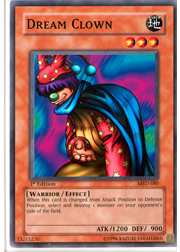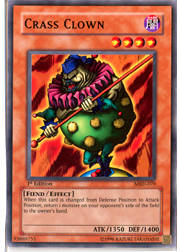If you spot me playing a trading card game other than Yu-Gi-Oh!, then it’s probably Vs. System. You might also note that I almost always play with some sort of deck that uses the Gotham Knights. Whether it’s running a theme that abuses the big bruiser known as Batman, The Dark Knight, or if I’m just running Alfred Pennyworth, Faithful Friend in all his glory, you’ll almost always see me using characters from the Batman universe. What can I say? I’m a Batman fanatic. I made sure to attend the midnight showing of Batman Begins when it premiered in theaters. If you were to look through my DVDs and videos, you’ll notice that I own the boxed sets of Batman: The Animated Series, as well as the original films from Tim Burton. It’s only expected that if I like Batman so much, I also like villains such as the Joker. Who doesn’t love that crazy clown, or his crazier and much more entertaining sidekick, Harley Quinn?
But this isn’t a Vs. System article, or even a Batman article. I’m talking about clowns today. Crazy clowns, like the Joker—or cool clowns, such as Harley Quinn. I’m specifically going into detail about one nifty clown from the Yu-Gi-Oh! Trading Card Game. Veterans rejoice, as Dream Clown is my focus for today’s edition of Bill and Tom’s Binder.
The Basic Breakdown
 Dream Clown is a peculiar little monster. Originally from the Metal Raiders booster set, Dream Clown’s ATK and DEF values are far from impressive. 1300 ATK isn’t going to get you anywhere, and 900 DEF leaves this little circus reject vulnerable to many monsters, such as Sangan. However, Dream Clown’s strength doesn’t lie in its stats, but rather in its effect.
Dream Clown is a peculiar little monster. Originally from the Metal Raiders booster set, Dream Clown’s ATK and DEF values are far from impressive. 1300 ATK isn’t going to get you anywhere, and 900 DEF leaves this little circus reject vulnerable to many monsters, such as Sangan. However, Dream Clown’s strength doesn’t lie in its stats, but rather in its effect.
Dream Clown, like many effect monsters in the Metal Raiders booster set, possesses an ability that’s triggered when it changes battle positions. However, unlike many similar monsters in Metal Raiders, Dream Clown’s effect was good enough to become the backbone of an entire deck concept. When Dream Clown is switched from attack position to defense position, its controller destroys one monster on the field. This effect may sound simple enough, but it’s an incredibly powerful Control element for the Stall deck in which this monster was used.
Back in the old days, duelists were excited over the release of Pharaoh’s Servant and Labyrinth of Nightmare. At this point, Dream Clown was teamed up with Crass Clown and some powerful level 3 monsters (such as Hayabusa Knight), along with powerful stall tools, such as Gravity Bind, in order to form a deck known as “Clown Control.” The old deck theme focused on abusing the slow but powerful effects of the Clown monsters, while your other level 3 monsters went after the opponent’s life points. Clown Control was a powerful counter to the metagame at the time, since most decks seen in tournaments back then consisted of multiple copies of the most powerful level 4 monsters.
Since the rise and fall of Clown Control, Dream Clown has seen a drastic decline in play. However, it’s still a powerful choice for Lockdown decks that need a field control element. Reinforcement of the Army is able to fetch Dream Clown from your deck now, so Control duelists can grab their key Control card early in the game. Newer and better stall cards have also made their way into the Yu-Gi-Oh! Trading Card Game, making Clown Control an option worth considering for duelists who wish to abuse an old competitive theme.
Combos and Counters
 One of my favorite combos with Dream Clown is with Labyrinth of Nightmare.* While this combo can be considered a bit slow, it allows you to automatically trigger Dream Clown’s effect during the turn you summon it. Labyrinth of Nightmare also allows you to set up monster removal or disruption once per turn, either with Dream Clown or with Crass Clown. Labyrinth of Nightmare also acts as a direct counter to Berserk Gorilla. If an opponent were to summon the big ape in attack position during their turn, it will be destroyed during the end phase because Labyrinth of Nightmare will switch it to defense position.
One of my favorite combos with Dream Clown is with Labyrinth of Nightmare.* While this combo can be considered a bit slow, it allows you to automatically trigger Dream Clown’s effect during the turn you summon it. Labyrinth of Nightmare also allows you to set up monster removal or disruption once per turn, either with Dream Clown or with Crass Clown. Labyrinth of Nightmare also acts as a direct counter to Berserk Gorilla. If an opponent were to summon the big ape in attack position during their turn, it will be destroyed during the end phase because Labyrinth of Nightmare will switch it to defense position.
Dream Clown also turns Zero Gravity into a form of mass removal. Zero Gravity not only disrupts an opponent’s battle phase, but it also switches Dream Clown’s battle position! If Dream Clown was stuck in attack position before you activated Zero Gravity, then it will be switched to defense position and will destroy one monster on the field. Now imagine if you had multiple Dream Clowns smacking down your opponent’s monsters. Zero Gravity can either trigger all of your Dream Clowns’ abilities, or it can switch them all to attack position—then you can switch their battle positions and trigger their effects during your next turn!
While this is not a combo with Dream Clown, the large amount of Warrior support can assist your circus Soldier and various other control-effect Warriors in the game. If you’re running two copies of Reinforcement of the Army, then consider running a copy of Exiled Force. This allows you to have options when you want to use your warrior-fetching spell card. The Warrior Returning Alive is also a solid form of recursion. While Monster Reincarnation possesses a cost and can return any monster to your hand, The Warrior Returning Alive returns your essential forms of monster removal to your hand in case your opponent finds a way to destroy them.
If you’re dealing with an opponent who has brought life into the old Clown Control theme, then your best bet of countering Dream Clown is to destroy what’s behind the opponent’s monsters—those continuous spell and trap cards! Clown Control duelists will utilize various forms of stalling and perhaps a few ongoing tricks such as Labyrinth of Nightmare and Level Limit – Area B. If you can destroy these spells and traps, then the opponent’s clown monsters will be left defenseless. After all, Dream Clown’s biggest weakness is its incredibly low ATK and DEF values.
Final Thoughts
Dream Clown easily fits into the category of “Cool Clowns.” Its effect is amazingly powerful in a heavy Control deck, and it was one of the only methods that could counter the Beatdown-heavy environment. It’s definitely a good idea for duelists to consider returning to “Clown Control” in a few months, in case the changes to the advanced format’s forbidden and restricted list encourage most players to focus on aggressive Beatdown decks and Swarm decks. Thanks to the addition of new cards over the past few years that contribute to Warrior and Lockdown decks, “Clown Control” can easily be revived and returned to its former glory.
 Please remember that Dream Clown isn’t the only necessity for the old Control theme. Crass Clown may by a level 4 Fiend, but its ability goes hand-in-hand with controlling the board, just like Dream Clown. Thanks to Level Limit – Area B, Crass Clown can also be triggered once per turn.
Please remember that Dream Clown isn’t the only necessity for the old Control theme. Crass Clown may by a level 4 Fiend, but its ability goes hand-in-hand with controlling the board, just like Dream Clown. Thanks to Level Limit – Area B, Crass Clown can also be triggered once per turn.
If anyone out there is toying with the idea of building a Clown Control deck and would like to chat about ideas, feel free to e-mail me at MRosenberg at metagame dot com. If enough people are interested, I’ll submit a few ideas that I’m tinkering with as well. Until then, keep on clowning around with your decks!**
*I wonder if anyone actually remembers what Labyrinth of Nightmare does, without clicking on the card name. Ancient Sanctuary is often ignored, and yet there are some really entertaining cards in the set.
**Mike Rosenberg and Metagame.com are not responsible for damage caused to the fragile minds of people who had to endure really bad puns in this or future articles. Feel free to blame Jason for the bad puns, though, even if he didn’t write them. Blaming him is fine by me.